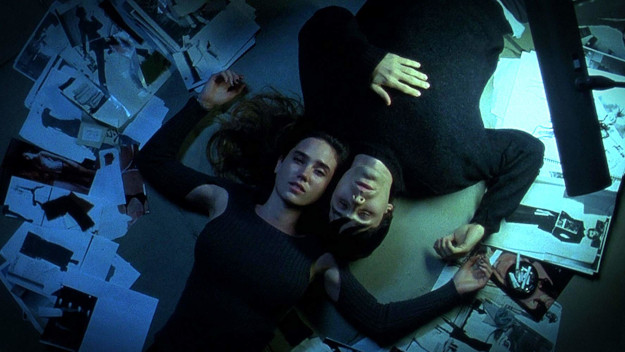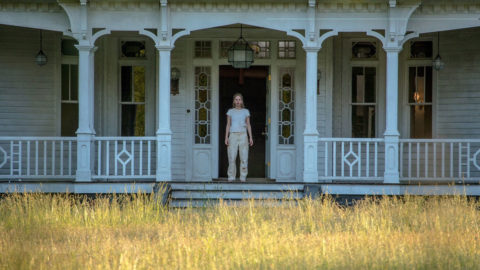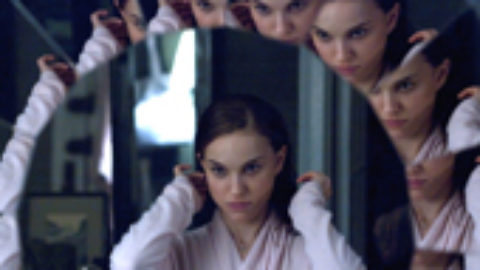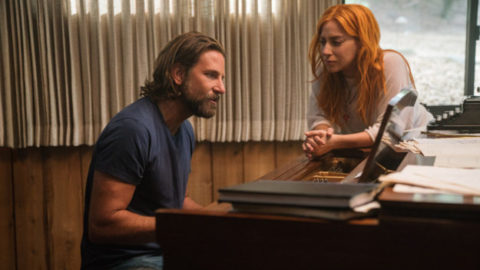Interview: Matty Libatique
This interview is part of a series with influential cinematographers who attended the 2018 EnergaCAMERIMAGE International Film Festival in Bydgoszcz, Poland.
At the 2018 EnergaCAMERIMAGE Film Festival, Matthew Libatique was nominated for his work shooting Bradley Cooper’s A Star Is Born. But it has been through Libatique’s two-decade-plus partnership with fellow New Yorker Darren Aronofsky, with whom he attended the AFI Conservatory in the early ’90s, that the Queens-born cinematographer has pushed into new frontiers. In films such as mother! (2017), Black Swan (2010), Requiem for a Dream (2000), and Pi (1998), he has boldly experimented with technique to create phenomenologically vivid, haptic images that express characters’ subjective states. At EnergaCAMERIMAGE, I interviewed Libatique about his experience probing the chaotic headspaces of Aronofsky’s protagonists, and the influences that forged his brazen, singularly hybrid vision. (Hours after our interview, Libatique was reportedly arrested following a late-night incident in Bydgoszcz; the matter was settled within the week.)

mother!
The cinematography in A Star Is Born is rooted in a relatively classical and straightforward approach. But the concert sequences stood out to me as a continuation of your work on another performance-driven film like Black Swan with those psychologically motivated light and color shifts, such as when Ally [Lady Gaga] steps on stage for the first time. Do you see each new movie as an opportunity to expand your technique?
Yes, I think so. Every film is custom-made, so I try to start anew each time. The only goal I really have is not to repeat myself, and I always find that I repeat myself in certain ways—that’s the struggle. But at the end of the day, I’m always trying to search for something new, whether in movement, color, or just approach, in terms of where the camera goes. Every film and every director deserves their own signature and interpretation. I don’t want to treat Bradley Cooper like I treat Darren Aronofsky, and I don’t want to treat Jon Favreau [e.g., Iron Man] like I treat Spike Lee [e.g. Chi-Raq, Inside Man]. I think they all have their own aesthetic, and my job is actually to tune into what their aesthetic is.
It’s funny that you said Black Swan, because now that I’m thinking about the performances and the choreography of the camera, there are probably similarities. But you know, Black Swan was very choreographed. After our day of prep at the office, Darren and I would go at night to do the rehearsals with Benjamin Millepied, the choreographer, and Natalie [Portman]. And I would have my [Canon] 5D, and either Darren or I would walk around and try to choreograph each sequence. It was very important for us, because we wanted Natalie to understand where the camera would be, but also Benjamin, so he knew how to choreograph the rest of the company when we would have them. We did the same thing on mother! for the entire film with the actors.
I’ve read that mother! involved a three-month rehearsal process in a warehouse.
It was crazy. Darren was rehearsing with the actors, and he brought me and a few people in around four weeks out of principal photography. Then we spent two weeks shooting the entire movie on a warehouse in Prospect Park. Darren wanted the actors to understand exactly how the film was going to be shot. He really likes to communicate the expectations to the actors about where the camera will be. I love watching him tell them, “You’re not gonna get a shot here. We’re gonna see it from here, you’re gonna be over there, no one’s gonna see it.” And then the actor goes, “Wait, so there’s no close-up?” and Darren goes, “No no no, we’re gonna be here. It’s a POV. Very subjective.” And then you have all these actors emoting, but the camera’s way over there. [Laughs]
You have a habit of breaking down the script through drawing a line diagram of the narrative structure and the protagonist’s pathway. I’m curious to hear what your diagram for mother! looked like, given the film’s ever-shifting, volcanic motion across the emotional spectrum.
You know, I started doing that on [Joel Schumacher’s] Tigerland, because it just seemed like every scene took place at daytime. So I did the line diagram, and I would highlight it in color in terms of tone, like a bright scene versus a dark one, or a night scene versus a day one. And then I would look at it and think, “Okay, this is a good way for me to sort of see the flow of the film color-wise.” So after that, I just did it for everything, as an exercise. But it’s kind of a silly thing, really—it’s only for me to see the flow of the movie. The cadence of light and dark, and of day and night, doesn’t work for me visually on a diagram. I prefer raising my hand.
So the diagram is not a tool you bring along to set?
No. To be honest, when I was a kid, I used to write very small cheat sheets for tests. And then I had a system: I would always wear pants that had five pockets so I could put my five cheat sheets in there. I would write in very small letters every piece of information I could, and then I would put one sheet in my left pocket, one in my right, one in my back, one in my right back, and then one in my small pocket. And I would just have it all with me. But because I did this, I already knew the information I needed to know. It’s the same thing with the timeline I do. Because I put it all down in writing before, I already know it. And Darren is a very mathematical person, so we both break things down in a very non-emotional way before we get to the emotional [part].
I know that Aronofsky expressed admiration for Sebastian Schipper’s one-take movie, Victoria, which he awarded with the Silver Bear for Outstanding Contribution for cinematography as Jury President of the 2015 Berlin Film Festival. Since mother! represents the epitome of subjective immersion in Aronofsky’s cinema with its dedication to immediacy and continuity, I wonder if you two ever contemplated going down the radical road of the single take.
I don’t know if it’s possible for Darren to do that. Honestly, he’s so edit-conscious—he knows how to accelerate things through the edit, and he does that on every film. You look at the pacing of every film he’s done, and it’s very driven by how he builds scenes rhythmically through the edit. So I don’t think it’s a desire for him. I was here at Camerimage a few years ago, and I saw Son of Saul—World War II, inside a camp, all hand-held. I was honestly blown away by that movie in terms of how committed it was in its language. So I called Darren and he had seen it too at another festival, and he was like, “I’m so happy you love that film.”
That never crossed my mind as a potential reference for mother!, but it does make perfect sense.
The notion of subjectivity is something Darren and I have been talking about since we were in film school together. And getting it better and better, and doing it in a more interesting way every time, have been a constant search over the six films we’ve collaborated on. So mother! was a culmination of years and years of thinking about subjectivity, and also when both of us saw Son of Saul separately, we said, “That kind of bravery is essential in a story like this.” When Darren sent me the first eighty pages of mother!’s script, I didn’t know if he was all right. I thought it was like a Kusturica nightmare, you know? And I said, “Are you okay?” I was actually concerned for a friend after I read the first 80 pages—the ending wasn’t even there yet, so imagine if I had seen that. [Laughter]
I think I’m always a film student, and because that script was riddled with metaphor and allegory, it was perfect for me. I love that, just the intellect behind it, the interwoven biblical reference and the suggestion of humanity. There are a lot of things in that film that people take literally, and they think about the sort of patriarchal relationship of the couple. But there are other layers to it as well that I think people missed at times. And I understand that, especially since the third act is accelerated so rapidly. Once you get to the third act, if you haven’t caught everything that’s happened before, you’re just gone. If your viewing experience only involves the surface layer of the couple’s relationship, that’s what you have. But if you caught all the references ahead of time, I think that you’re on a journey.
Can you describe your process of shooting that film’s apocalyptic final act? As a camera operator, how do you experience maintaining such a heightened relationship with the character whose subjectivity you infiltrate and transcribe on the screen? Was it as equally excruciating for you as it was for Jennifer Lawrence?
It was excruciating for everyone. I mean, Darren’s movies are always excruciating to make. [Laughs] But I actually had a camera operator on mother!, so I didn’t operate myself. It’s a funny process, like casting. We had to find somebody who was Jennifer’s height, because Darren always wants the hand-held camera to be the height of the actor. And Jennifer is taller than me, so I couldn’t operate.
That’s hilarious.
Yeah, it’s always about the height of the actor. But in terms of how the sequence was shot, we started shooting Jennifer first. There were basically three shots: a medium close-up/close-up of her leading her through the space, an over-the-shoulder follow shot of her, and then her POV—that’s literally the coverage scheme. We started shooting her first out of courtesy because she’s the actress, but she didn’t know what she was reacting to: the scene wasn’t fully formed around her yet, and she just couldn’t get there emotionally. When we realized that, we started shooting her POV and over-the-shoulder first, so that we could stage the chaos around her. But that means she had to wait forever to get to the shot of her face. Meanwhile, the shot of us going through the space behind her became our master, and we could fine-tune the chaos happening around. Jennifer had to wait for so long, but she never complained, and I think it helped her performance-wise. At least she was able to experience emotionally what was happening.
She took it all in.
Exactly. It was almost like her rehearsal, and then by the time we got to her, she was just electric.

Requiem for a Dream
I also wanted to touch upon the interplay of sound and picture with regard to the construction of subjectivity. In a film as psychedelic as Pi, the images and the soundscape are truly inextricable from each other in delineating the protagonist’s nervous breakdown. While preparing Pi, were you aware that sound design would end up playing such a prominent role in it, and how much did you base your visualization of the script on this visceral complicity between image and sound?
I used to think that images weren’t complete until Clint Mansell put his music on top of them.
Was his music for Pi ready before the shoot?
We heard it, but we didn’t play it on set or anything. Before we started shooting, we would listen to it to get a taste, but then it became this whole other thing, an iconic score. Something about what Clint did specifically, was like the glue to the film as a whole. But sound is something I’m very aware of, because Darren was already obsessed with it at film school. I remember noticing him obsessing over the sound mixer’s work and giving him notes. Who does that? At least nobody else that I went to film school with did. We met Brian Emrich, a very quirky man and a brilliant sound designer, on Pi, and he became as important a collaborator to Darren as myself. Darren uses every aspect of the filmmaking process to his advantage. He is so attuned to editing that the shots have to be very specific on their out-points and in-points, and he is as equally attuned to sound and how he can accentuate the narrative that way.
How involved are you in the postproduction of Aronofsky’s films? For example, were you present during mother!’s CGI phase?
Darren’s whole team is a family, so I’m included in anything that involves visuals. But I don’t spend time in the editing room. I have a very hard time watching the first edit of a film, because I see my own mistakes and get upset over cuts, so I have to let it marinate a bit. But I do get shots to look at and then I end up delving in a little further, wondering about placement: “What comes in front of this? Which shot?” So they show me a little cut, then they send me a bit more, and I’m like, “Don’t send me any more. I don’t want to see it!” [Laughs] But I think it’s very important for cinematographers to be involved in postproduction these days, because so much happens there. On mother!, there were quite a few [CGI] shots that Darren wanted my eyes on—he doesn’t let anything go unless I bless it, which is a high honor. As [much of the] author as he is, Darren is extremely collaborative: everybody is a partner, and has a signature and authorship about what they do, which goes back to what I was saying about sound. Darren demands enough of every person so there’s a pride in the work. Everything is on a caliber between 8 and 10, so cinematography is at 10 in this scene and sound is at 9, or sound is at 11 in this other scene and cinematography is at 9. Darren is like a mixer, dialing everybody’s level up, and the extent to which you can sort of go down the rabbit hole intellectually on his films is astounding. Sometimes, when I’m preparing, I find myself staring at the floor, like a writer. [Laughs]
To shift gears completely, can you talk about growing up in Queens in the ’80s, and how your exposure to hip-hop and graffiti informed the heterogeneous aesthetic of Requiem for a Dream?
Hip-hop made its mark in the mid-’80s, when I was in high school, and became the new punk in the transition from hard rock and disco. I think that’s where Darren and I connected in film school, because we’re both from that generation and had similar roots growing up, with music and all these filmmakers who were coming up being a large part of it. When I first started getting into the film business, Spike Lee and [his cinematographer] Ernest Dickerson were iconic to me, and so I feel fortunate to have found a director that I have been with for so long myself. In the late ’80s and early ’90s, you had Public Enemy, but you also had films from Jim Jarmusch and Spike Lee, who were so young and youthful. Until I saw Do the Right Thing and She’s Gotta Have It, I didn’t think that a person like myself would even be able to think about making films for a living. So what those guys did single-handedly democratized it all, and it became possible to make independent films. Then Robert Rodriguez came out with El Mariachi, and Richard Linklater with Slacker, and that world changed. When Darren and I met in the early ’90s, music was Public Enemy, EPMD, N.W.A.—it was motivating. It wasn’t politicizing per say, but it made everybody feel empowered, and it made me feel empowered to ask, “What’s my part in this popular culture?”
In the late ’80s and early ’90s, we were going through the whole Reagan era into the Bush I era, but there was a countercultural movement that exploded with a voice. A lot of it was coming out of the fact that there was this anger, this collective rage. And I always thought that might happen now, but it hasn’t. It was the first thing I thought about after the 2016 elections, because I had experienced that magic before, but the reason why it hasn’t happened might be that our popular culture is so over-saturated. It was focused back then, because we had less outlets. You were listening to Public Enemy on the one hand, and to Jane’s Addiction on the other, and then to the Pixies, and so all these bands that were coming out influenced us.
As a prolific cinematographer of music videos, do you perceive any interaction between that process and your filmmaking experience?
I used to say that you always come back to the band, and so when I’m working on a film, I try to figure out what the band is in each scene. In mother!, the band is Jennifer Lawrence. If we don’t get a certain moment right, we can always come back to her. Music videos are an incredible place to check out technique, but at the end of the day, they’re just promo. In rare instances, they’re art, but mostly, they’re just commercials for a band. But I like to think that if you’re lucky enough to have an interesting, memorable concept, a music video is an amazing opportunity to make a piece of film with music. It’s a common thing to hear people say, “You make music videos, that’s why you make more interesting films.” I don’t think that’s necessarily true. There’s a strict discipline to making a film that doesn’t exist on music videos, and for me, it’s a never-ending search to master the discipline of cinematic storytelling.
You often mention Do the Right Thing as the film that sparked your interest in cinema. As a film student, you were also heavily influenced by Robert Richardson’s cinematography in JFK. Actually, the interlacing of different levels of reality in The Fountain is quite reminiscent of that film’s exploration of the fragmented temporality of trauma…
Robert Richardson and Oliver Stone were a [duo] to follow and appreciate, just like Dickerson and Lee, Storaro and Bertolucci, or Nykvist and Bergman—you’ll notice I say the cinematographer’s name first. [Laughs] The one very influential thing that Bob did early in his career was applying technique appropriately to things. I like to say that I used to pour a lot of sugar in my coffee, and in Requiem, we really poured it on: there’s a lot of technique in that film. There’s nothing wrong with technique; it’s like a guitar solo, a flourish or a riff in between a melody. I feel like as long as it’s well placed, it’s not trite or cheap. But you have to be tasteful with technique, or else it gets out of hand. The use of technique was so creative on films like JFK and Natural Born Killers, that it came across as an expression. Especially when you’re a young filmmaker, you have this need to express yourself in many different ways. But I don’t like to repeat myself, and as I’ve gotten older, I think that I just naturally kind of mellowed out. Ultimately, I’m appreciating different things in movies because I’m in the game. Whereas I used to love Oliver Stone and Bob Richardson, now I watch a Lucrecia Martel.
Yonca Talu is a filmmaker living in Paris. She grew up in Istanbul and graduated from NYU Tisch.







